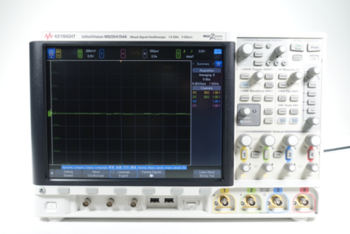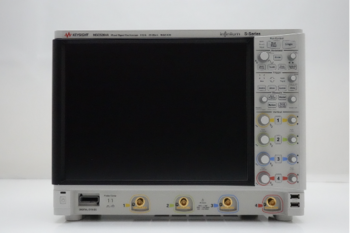- Introduction
- Understanding Radio Frequency (RF)
- Radio Waves and Propagation
- RF Spectrum and Frequency Bands
- RF Components
- Applications of RF
- Testing RF Signals with Oscilloscopes
- Using Oscilloscopes for RF Testing
- Special Considerations for RF Signal Testing
- Steps for Testing RF with an Oscilloscope
- Challenges in RF Engineering
- Future of RF Engineering
- Conclusion
- Whenever You’re Ready, Here Are 4 Ways We Can Help You
Imagine a world without RF, or Radio Frequency technology. This would mean not only losing your handheld devices, but also the ability to forecast weather, navigate the seas, and even heat your leftovers! Believe it or not, Radio Frequency technology, the unseen force behind all modern communication, drives all these functionalities and more.
This article takes a deep dive into this invisible force, breaking down its fundamental aspects, applications, challenges, and future prospects.
Buy Oscilloscopes at a Great Discount
Understanding Radio Frequency (RF)
RF, or Radio Frequency, is a term that describes a range of electromagnetic waves with frequencies from 20 kHz to 300 GHz. These frequencies form part of the electromagnetic spectrum that is utilized for various wireless communication technologies.
Radio Waves and Propagation
Radio waves, a type of electromagnetic wave, are characterized by the frequency and wavelength. The wavelength gets shorter as the frequency increases. They are generated by electronic devices and circuits, and they propagate through space at the speed of light.
Radio wave propagation occurs in several ways:
- Line of sight: Direct transmission between antennas that are visible to each other.
- Ground wave: Low-frequency waves that follow the curvature of the earth.
- Skywave: Waves that are reflected by the ionosphere back to the earth.
- Scatter: Waves that are diffused in multiple directions due to hitting certain atmospheric phenomena.
| Key Takeaway |
|---|
| Radio Frequency technology, which drives everything from wireless communication to medical equipment, forms an indispensable part of modern life. As we move into an increasingly connected world, the role of RF engineering will become even more critical, requiring skilled engineers who can navigate the complexities and challenges of this evolving field. |
RF Spectrum and Frequency Bands
The RF spectrum is divided into several bands, each with its own specific applications. Here's a brief overview:
| Frequency Band | Frequency Range | Common Applications |
| Low Frequency (LF) | 30 kHz to 300 kHz | Navigation, time signals |
| Medium Frequency (MF) | 300 kHz to 3 MHz | AM radio |
| High Frequency (HF) | 3 MHz to 30 MHz | Shortwave radio, amateur radio |
| Very High Frequency (VHF) | 30 MHz to 300 MHz | FM radio, TV broadcasts, aviation communication |
| Ultra High Frequency (UHF) | 300 MHz to 3 GHz | TV broadcasts, cellular service, Wi-Fi |
| Super High Frequency (SHF) | 3 GHz to 30 GHz | Satellite communication, Wi-Fi, radar |
| Extremely High Frequency (EHF) | 30 GHz to 300 GHz | Satellite communication, radar, experimental medical and scientific applications |

RF Components
RF systems typically comprise a series of components, each designed to perform specific tasks:
- Transmitters: Devices that generate RF signals
- Receivers: Devices that accept RF signals
- Antennas: Used to send and receive RF signals
- Amplifiers: Used to increase the power of RF signals
- Filters: Devices that allow signals within a certain frequency range to pass and attenuate signals in other frequencies
- Mixers: Used to change the frequency of the signal
- Oscillators: Devices that generate a waveform at a specific frequency
Applications of RF
RF technology has a broad range of applications, including but not limited to:
- Wireless Communication: RF is used in various wireless communication systems such as mobile phones, Wi-Fi, and Bluetooth.
- Broadcasting: Television and radio broadcasting are major applications of RF.
- Radar Systems: RF waves are used in radar systems to detect the position and speed of distant objects.
- Satellite Communication: RF waves are used for data transmission between a satellite and Earth.
- Medical Applications: Certain medical equipment such as MRI machines and RF ablation equipment use RF waves.
Testing RF Signals with Oscilloscopes
Testing RF circuits requires specialized tools like oscilloscopes, network analyzers, and spectrum analyzers.
Using Oscilloscopes for RF Testing
Oscilloscopes are crucial tools for electrical engineers, allowing them to visualize the change of an electrical signal over time. They are often used for:
- Monitoring the quality of signals
- Detecting noise or distortion in signals
- Measuring signal amplitude, frequency, and phase
Special Considerations for RF Signal Testing
RF testing involves several unique challenges:
- High-frequency signals can be attenuated or reflected by cables and connectors.
- RF signals are susceptible to external interference.
- Precision equipment like vector network analyzers are needed to accurately measure the phase and magnitude of RF signals.
Steps for Testing RF with an Oscilloscope
Testing RF signals accurately is crucial for the performance of any RF system. The oscilloscope is one of the most powerful tools for engineers in this context. Here's a detailed process of measuring RF with an oscilloscope:
- Preparation of Your Equipment: Make sure that your oscilloscope and any other test equipment you have are working properly. Your oscilloscope should be properly calibrated, and the settings should be zeroed out before starting any measurements. It's also essential to ensure that your test environment is free from excessive noise, vibrations, or any other factors that might influence the measurements.
- Calibration: Calibration is a vital step to ensure that your measurements are accurate. Connect a known signal source, such as a signal generator, to the oscilloscope and adjust the probe compensation until the waveform displayed matches the known signal's parameters.
- Probe Connection to the Device: The oscilloscope probe must be securely attached to the RF device or circuit you are testing. This ensures a proper electrical connection, thus minimizing signal loss or distortion. Different types of probes are available, like active, passive, single-ended, and differential probes, so choose the one that best suits your measurement needs.
- Adjusting Oscilloscope Settings: Now, it's time to adjust the vertical (y-axis) and horizontal (x-axis) scale on the oscilloscope. The vertical scale determines the amplitude of the signal, while the horizontal scale correlates to time, allowing you to view the signal frequency. You might also want to set the oscilloscope to the RF signal's appropriate bandwidth.
- Capturing the Signal: Use the trigger function of the oscilloscope to stabilize the waveform display on the screen. By setting the trigger level (a specific voltage level), you can capture the waveform at the exact moment it crosses this level, allowing for precise measurements. Depending on the oscilloscope model, you may have advanced triggering options that allow you to capture more complex signal events.
- Analysis of the Signal: Once the signal is properly displayed, you can now analyze the waveform. Use the oscilloscope's measurement features to calculate the parameters you're interested in. This might include peak-to-peak voltage, root-mean-square (RMS) voltage, frequency, period, or phase shift. Oscilloscopes may also provide features for more advanced analysis, like Fast Fourier Transform (FFT) for frequency domain analysis.
- Recording Measurements: The final step is to record your measurements for future reference or further analysis. Some oscilloscopes come with built-in data storage options, allowing you to save waveforms and measurement results directly. Remember to annotate your records clearly, indicating what each measurement pertains to and the conditions under which it was taken.

Challenges in RF Engineering
RF engineering comes with several challenges:
- Designing Complex Systems: Designing RF systems can be complicated due to the high frequencies, impedance matching, and the need for high-precision components.
- Interference: RF systems can interfere with each other, leading to performance issues.
- Regulatory Compliance: RF devices must comply with regulations related to frequency usage and power levels.
Future of RF Engineering
The RF field is evolving at an unprecedented pace due to advancements in technology and the growing demand for wireless communication. Trends shaping the future of RF engineering include:
- 5G and Beyond: The deployment of 5G and the development of 6G necessitate advancements in RF technology.
- Internet of Things (IoT): The increasing number of IoT devices require innovative RF solutions for efficient communication.
- Software-Defined Radio (SDR): SDR is set to revolutionize RF engineering by providing flexibility and cost savings in system design.
Conclusion
The RF spectrum, with its diverse frequency bands, enables everything from broadcasting and satellite communication to medical applications and more. RF engineering, however, is not without challenges, requiring meticulous system design, interference mitigation, and strict regulatory compliance.
Testing and measuring RF signals play a vital role in ensuring the efficiency of RF systems, and tools like oscilloscopes become invaluable in this process. However, the rapid evolution of RF technology, propelled by the advancements in 5G, Internet of Things (IoT), and Software-Defined Radio (SDR), also calls for continuous learning, adaptation, and investment in the right testing equipment.
If you're ready to delve deeper into RF, ensure your toolbox is equipped with the best. Discover Keysight's Used Equipment Store and invest in reliable, pre-owned RF test equipment. Whether it's for complex system design, battling interference, or ensuring regulatory compliance, make Keysight your trusted partner. Explore the Keysight Used Equipment Store and equip yourself with the tools that pave the way for a successful RF testing.

Browse Oscilloscopes at a Great Discount
Whenever You’re Ready, Here Are 4 Ways We Can Help You
- Browse our Premium Used Oscilloscopes.
- Call tech support US: +1 800 829-4444
Press #, then 2. Hours: 7 am – 5 pm MT, Mon– Fri - Talk to our sales support team by clicking the icon (bottom right corner) on every offer page
- Talk to your account manager about your specific needs

































































































